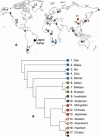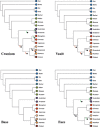Evolutionary population history of early Paleoamerican cranial morphology
- PMID: 28261661
- PMCID: PMC5321447
- DOI: 10.1126/sciadv.1602289
Evolutionary population history of early Paleoamerican cranial morphology
Abstract
The nature and timing of the peopling of the Americas is a subject of intense debate. In particular, it is unclear whether high levels of between-group craniometric diversity in South America result from multiple migrations or from local diversification processes. Previous attempts to explain this diversity have largely focused on testing alternative dispersal or gene flow models, reaching conflicting or inconclusive results. Here, a novel analytical framework is applied to three-dimensional geometric morphometric data to partition the effects of population divergence from geographically mediated gene flow to understand the ancestry of the early South Americans in the context of global human history. The results show that Paleoamericans share a last common ancestor with contemporary Native American groups outside, rather than inside, the Americas. Therefore, and in accordance with some recent genomic studies, craniometric data suggest that the New World was populated by multiple waves of dispersion from northeast Asia throughout the late Pleistocene and early Holocene.
Keywords: cranial shape; geometric morphometrics; peopling of Americas; population history.
Figures



Similar articles
-
Human cranium of Candonga Cave site and its implications for the initial peopling of South America.Homo. 2019 Nov 29;70(4):283-295. doi: 10.1127/homo/2019/1118. Homo. 2019. PMID: 31651933
-
Early South Americans Cranial Morphological Variation and the Origin of American Biological Diversity.PLoS One. 2015 Oct 14;10(10):e0138090. doi: 10.1371/journal.pone.0138090. eCollection 2015. PLoS One. 2015. PMID: 26465141 Free PMC article.
-
Holocene population history of the Sabana de Bogotá region, Northern South America: An assessment of the craniofacial shape variation.Am J Phys Anthropol. 2017 Feb;162(2):350-369. doi: 10.1002/ajpa.23124. Epub 2016 Oct 31. Am J Phys Anthropol. 2017. PMID: 27796034
-
Lagoa Santa's contribution to the origins and life of early Americans.Evol Anthropol. 2018 May;27(3):121-133. doi: 10.1002/evan.21587. Epub 2018 May 30. Evol Anthropol. 2018. PMID: 29845689 Review.
-
A genomic view of the peopling of the Americas.Curr Opin Genet Dev. 2016 Dec;41:27-35. doi: 10.1016/j.gde.2016.06.016. Epub 2016 Aug 6. Curr Opin Genet Dev. 2016. PMID: 27507099 Free PMC article. Review.
Cited by
-
Reconstructing the Deep Population History of Central and South America.Cell. 2018 Nov 15;175(5):1185-1197.e22. doi: 10.1016/j.cell.2018.10.027. Epub 2018 Nov 8. Cell. 2018. PMID: 30415837 Free PMC article.
-
Morphological variation of the early human remains from Quintana Roo, Yucatán Peninsula, Mexico: Contributions to the discussions about the settlement of the Americas.PLoS One. 2020 Jan 29;15(1):e0227444. doi: 10.1371/journal.pone.0227444. eCollection 2020. PLoS One. 2020. PMID: 31995578 Free PMC article.
-
Tracing Human Diversity in South America's Southern Cone: Linguistic, Morphometric, and Genetic Perspectives.Am J Biol Anthropol. 2025 Jul;187(3):e70077. doi: 10.1002/ajpa.70077. Am J Biol Anthropol. 2025. PMID: 40579880 Free PMC article.
-
How strong was the bottleneck associated to the peopling of the Americas? New insights from multilocus sequence data.Genet Mol Biol. 2018;41(1 suppl 1):206-214. doi: 10.1590/1678-4685-GMB-2017-0087. Genet Mol Biol. 2018. PMID: 29668018 Free PMC article.
-
Normal and altered masticatory load impact on the range of craniofacial shape variation: An analysis of pre-Hispanic and modern populations of the American Southern Cone.PLoS One. 2019 Dec 11;14(12):e0225369. doi: 10.1371/journal.pone.0225369. eCollection 2019. PLoS One. 2019. PMID: 31826020 Free PMC article.
References
-
- Hubbe M., Okumura M., Bernardo D. V., Neves W. A., Cranial morphological diversity of early, middle, and late Holocene Brazilian groups: Implications for human dispersion in Brazil. Am. J. Phys. Anthropol. 155, 546–558 (2014). - PubMed
Publication types
MeSH terms
LinkOut - more resources
Full Text Sources
Other Literature Sources

